The Everglades is a vast wetland area in Florida. It is the largest subtropical wetland ecosystem in North America.
It has also been referred to as merely a very slow-moving river. However, this description does nothing to indicate its significance. The Everglades spans up to 1.5 million acres.
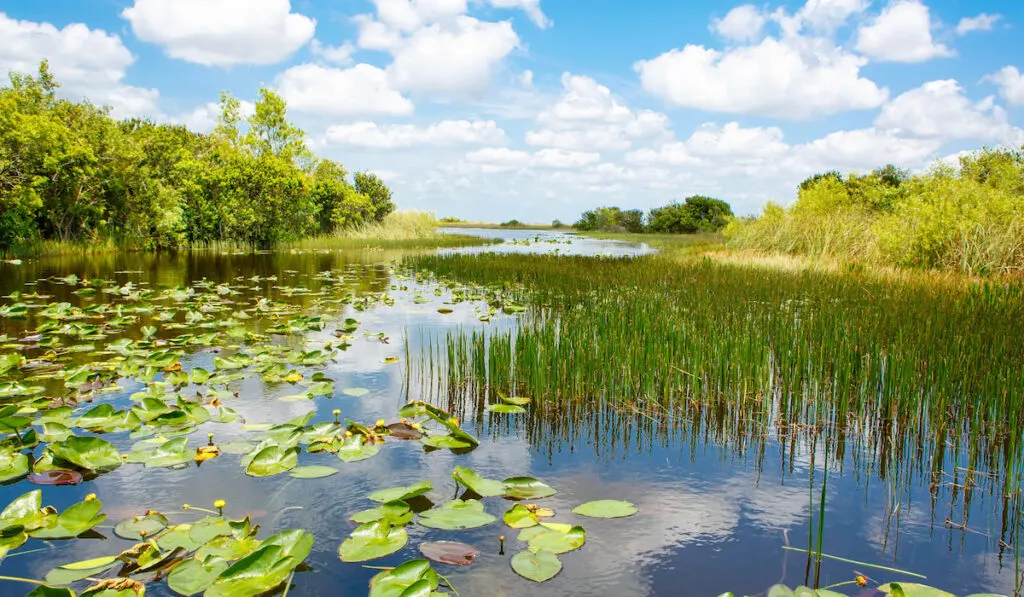
The Everglades also has a rich wildlife profile. It is home to over 350 different animal species, with up to 30 of them listed as endangered.
One of the birds you will see in the Everglades is the Purple Gallinule. This colorful bird is a type of swamphen – small aquatic birds that share a resemblance to domestic hens.
In this post, we will discuss all you need to know about the Purple Gallinule. You will also find out if maybe, you can keep one as a pet. Keep reading.
Table of Contents
Description
As you might guess from the name, the Purple Gallinule appears with a lot of purple.
An adult bird has distinct purple-blue plumage, both on the head and body. In good light, the purple hue on the body often shines green.
The bird’s head has a pale-blue front shield that connects to a red and yellow bill. The unusual colors even extend to its legs, which are pale-yellow.
The juvenile Purple Gallinule presents with hints of these colors, though mostly appearing as light brown on the wings and back.
The legs of the juvenile are mostly brown.
The bird is medium-sized, with a wingspan of up to 24 inches. The males are slightly larger than the females.
All Purple Gallinules have long legs with equally long toes that help when walking on floating vegetation.
Their foot setup also makes it easy for them to climb plant stems. Although it is a flying bird, it usually doesn’t do long distances.
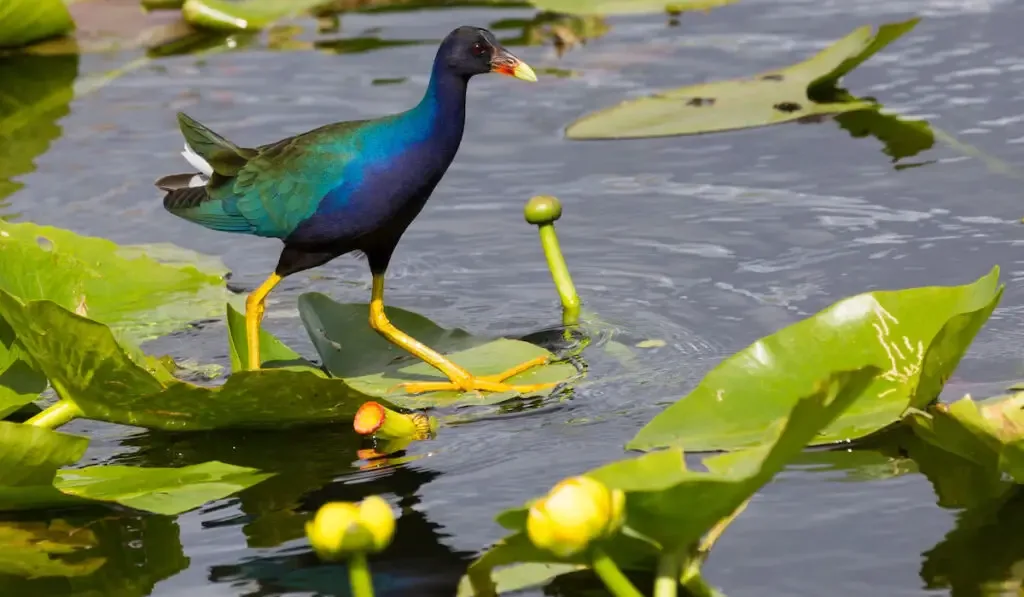
Range
The Purple Gallinule is found mostly in the southeastern US states of South Carolina, Arkansas, Mississippi.
They are more apt to be found in southern Florida, the Pacific Coast, the Gulf of Mexico through the Caribbean, and Central and South America during the breeding season.
Purple Gallinules are strongly migratory, and that is why you may find them as far north as Canada. They also fly as far as Argentina during winters.
Habitat
The Purple Gallinule prefers freshwater areas. You will easily find them in marshes, swamps, lagoons, and ponds, essentially any wetland places with abundant grasses, sedges, and rushes.
Floating vegetation forms an essential part of the Purple Gallinule’s ideal habitat.
Some of these plants include pickerelweed, arrowhead, water pennywort, spatterdock, American lotus, and lily pads.
The aquatic vegetation is essential for its foraging, and most importantly, its nesting and breeding practices. However, you may see non-breeding individuals in more open environments.
Freshwater is vital for this bird. Even when they migrate, they stay as near to it as possible.
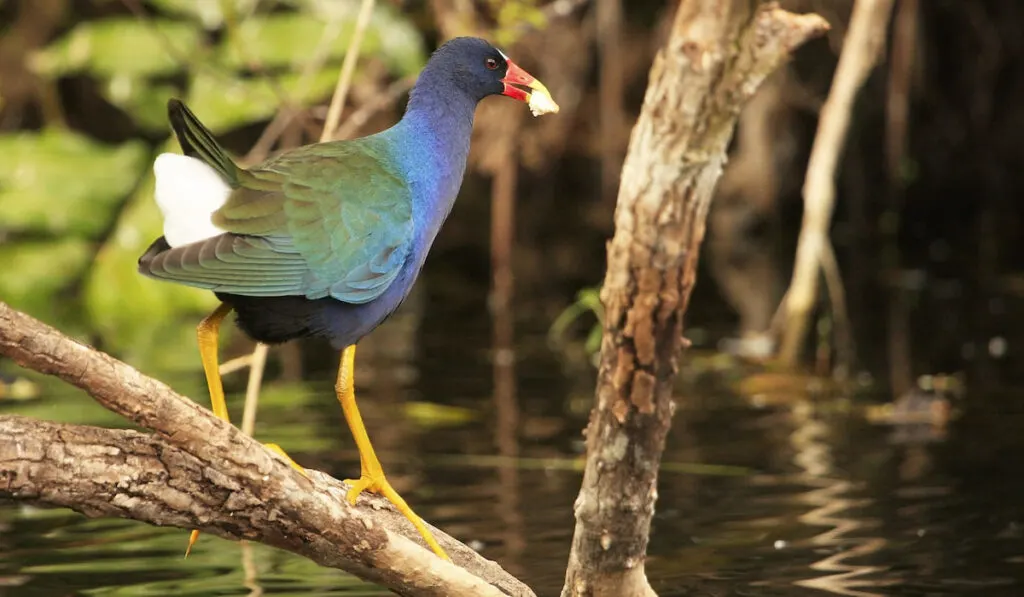
Diet
Purple Gallinules consume a wide variety of plant and animal foods – they are omnivorous.
Their food includes leaves, seeds, and fruits from terrestrial and aquatic plants.
They also feed on various small animals on land and in the water.
Arguably, the diet of a Purple Gallinule consists of a higher percentage of plants than animals.
A popular plant with this bird is the American lotus, particularly its flowers and fruits. Water hyacinth, hydrilla, and even rice, which are invasive exotic plants in the Everglades, are also highly consumed.
The Purple Gallinule feeds on the tubers, leaves, and flowers of these plants.
Weeds and the seeds of various aquatic plants, including different sedges, are not left out.
These include pickerelweed, water willow, sawgrass, buttonbush, and smartweed, amongst others.
The animal portion of their diet consists of a great variety of insects, worms, and aquatic animals.
These include dragonflies, snails, moth larvae, fish, leeches, beetles, spiders, grasshoppers, earthworms, bees, frogs, and ants.
Lastly, the Purple Gallinule also feeds on the eggs and young of other species of birds.
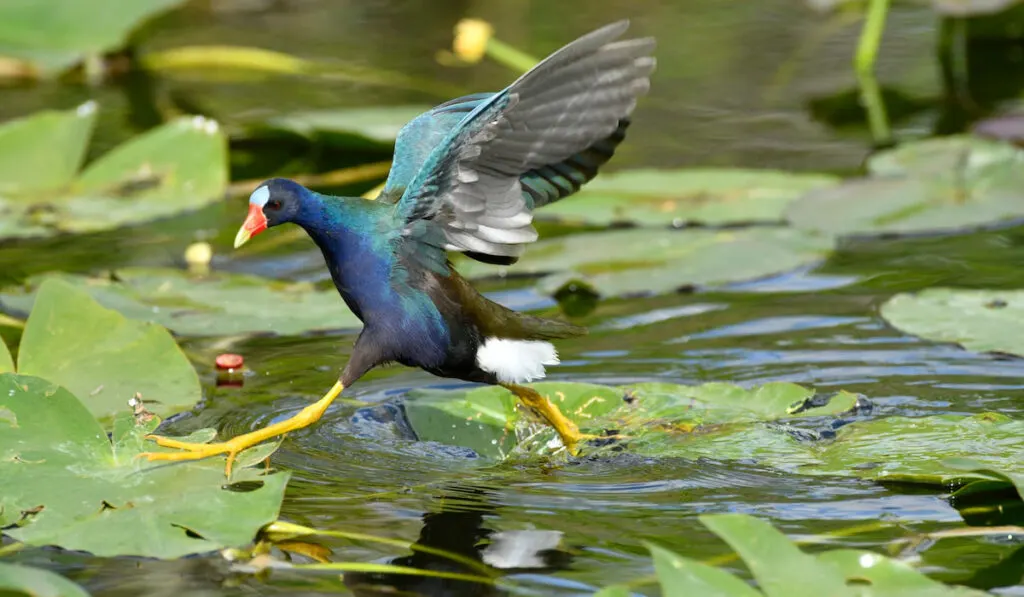
Behavior
The Purple Gallinule is a daytime bird that enjoys solitude when it is not breeding. At the slightest hint of any disturbance, it takes to cover, swims, flies, dives, or runs away.
The bird forages at the edge of the water, walking along the margins. Its adapted feet distribute the bird’s weight evenly, allowing it to walk on floating vegetation.
It is an agile climber, getting up to as high as 65 feet for food, again, thanks to its toes.
Although it is a good swimmer, it prefers to stay away from open water for fear of predators.
Furthermore, Purple Gallinules are less than average at flying and generally only go short distances. When in the air, their legs are left dangling. Flight is slow and there is a lot of wing flapping.
Also, the Purple Gallinule can be a noisy bird. It cackles, squawks and grunts. During flight, it produces a kek-kek-kek sound, while it emits a keh-keh-keh cackling when startled.
Nesting
Purple Gallinule nests can take different forms.
Purple Gallinules build their nests in various collections of floating vegetation, marsh grasses, or aquatic plants.
Floating vegetation piles can reach as high as 2.6 feet above water level and can be moved by the wind.
The birds build the nests with sedges, grasses, and rushes affixed to standing vegetation or on the floating piles.
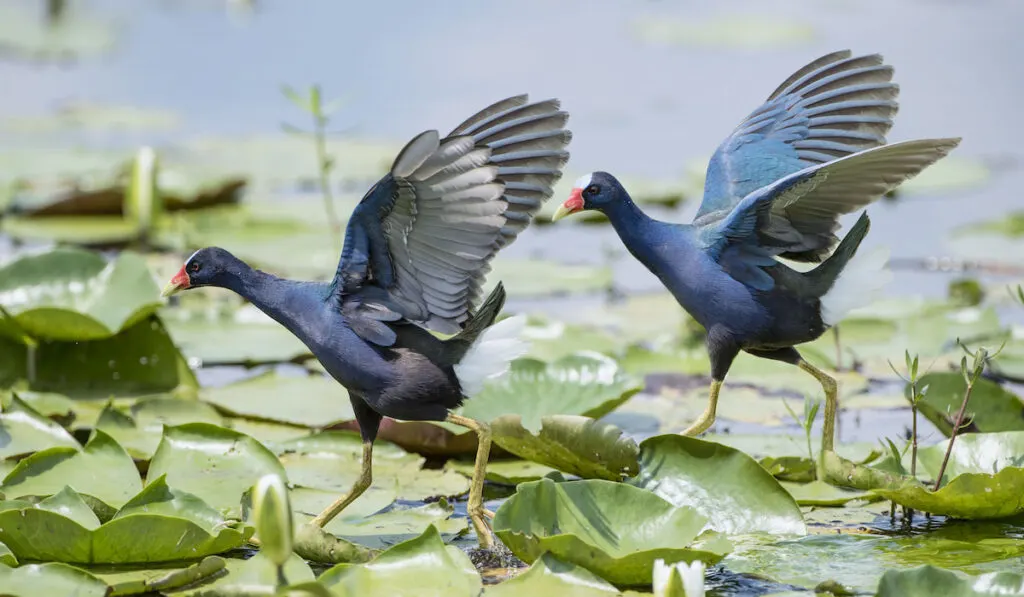
The nests are cup-shaped and measure up to 11 inches long and 3.5 inches wide. Purple Gallinules also build some of their nests to have roofs or half-roofs.
This serves to protect parents who are incubating from weather that could be harmful to the process. Some nests are even built with patches of vegetation that lead to the actual nests.
Though just one nest is usually used for incubation and egg-laying, Purple Gallinules may construct up to four. After incubation, the parents can choose to move the young hatch from one nest to the other.
Since it is difficult to differentiate between male and female birds, it is also challenging to specify male and female nests. However, both sexes contribute to constructing the nests.
Egg Care and Mating Habits
Purple Gallinule eggs are creamy, buff, or pale pink. They also have brown spots irregularly dotted on them.
The length of these eggs ranges from 1.3-1.7 inches, while the width ranges from 0.9-1.3 inches.
Purple Gallinules produce a clutch size ranging from 5-10 eggs. Both the male and female are responsible for incubation, which lasts for an average of 18-20 days up to a maximum of 25 days. They are a monogamous species.
These birds are also communal, as the new parents usually get help from up to 8 other birds in feeding the hatchlings. Most of the extra supporters are older offspring of the pair.
A chick becomes independent at 9 weeks old when it begins to fly.
Purple Gallinules have a complex, unique courtship dance that involves both partners simultaneously.
The chicks are hatched with open eyes, and they are able to leave the nest within 24 hours if necessary.
Purple Gallinules mate in North America from May to August and in South America from March to November. The lifespan of a Purple Gallinule is 22 years.
Predators
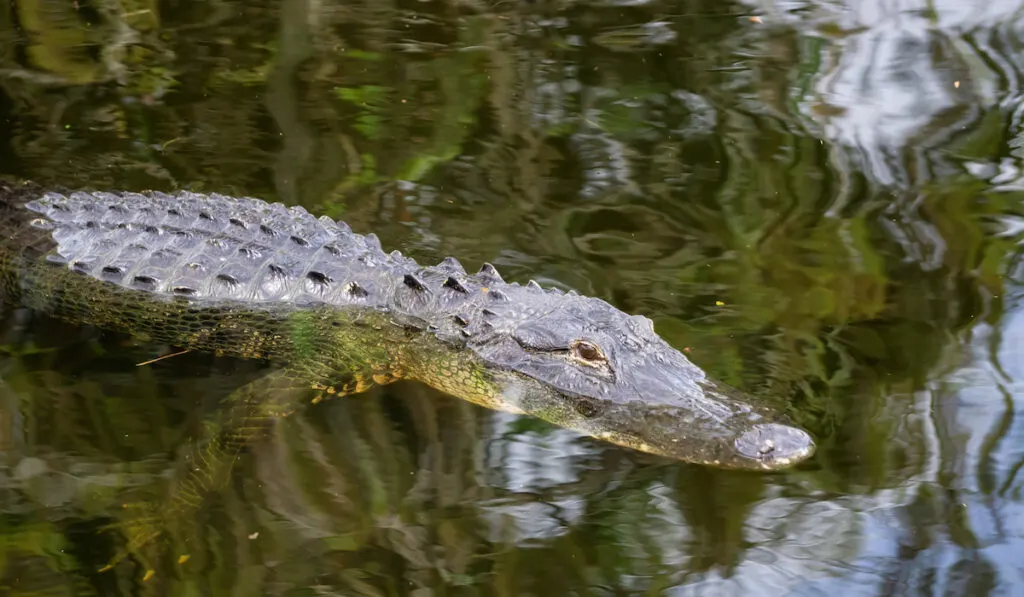
The major predators for the Purple Gallinule are fellow freshwater companions – alligators. They may also be preyed upon by turtles.
Pet Status
Historically, evidence supports the claim that Purple Gallinules were kept in captivity and reared by humans.
The bird’s beautiful colors and interesting human-like behaviors, such as washing its food and loyalty to its mate for life, made it a favorite of ancient societies in the Mediterranean.
However, with all the specificities required to thrive, it may be difficult to keep modern Purple Gallinules as pets.
Resources
- https://www.audubon.org/field-guide/bird/purple-gallinule
- https://seaworld.org/animals/facts/birds/purple-gallinule/
- http://animalia.bio/purple-gallinule
- https://www.birdwatchersdigest.com/bwdsite/learn/identification/wading-birds/purple-gallinule.php
- https://www.allaboutbirds.org/guide/Purple_Gallinule/lifehistory
- https://www.allaboutbirds.org/guide/Purple_Gallinule/id
- https://www.allaboutbirds.org/guide/Purple_Gallinule/overview
- https://nhpbs.org/wild/purplegallinule.asp
- http://www.oiseaux-birds.com/card-purple-gallinule.html
- https://brill.com/view/journals/soan/24/6/article-p574_4.xml?language=en
